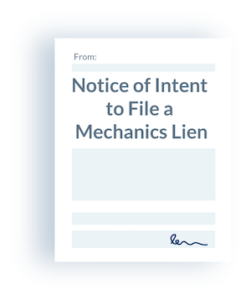
Mechanics lien notice and service requirements can be confusing; particularly in Connecticut. However, it’s important to understand and comply with all the requirements in order to be sure you’ve secured mechanics lien rights. This guide will explain all the complex, and sometimes frustrating, Connecticut notice and service requirements for private construction projects.
Connecticut notice requirements
The state of Connecticut has a particularly complex notice scheme that must be followed in order to secure the right to file a mechanics lien. There are no traditional preliminary notice requirements like many other states, but there are at minimum two different notice that must be sent in order to have a valid mechanics lien claim.
Connecticut Notice of Intent to Lien
The first of these two notices is a formal Notice of Intent to Lien, which is regulated under Conn. Gen. Stat. §49-35. This type of notice is a requirement for any party on private construction projects that didn’t contract directly with the property owner.
This notice needs to be served anytime within the lien filing period; which in CT is 90 days of the date of the last furnishing of labor or materials to the project. A Notice of Intent needs to be served on the property owner and, if the prime/general contractor filed a Contractor Affidavit form, then to the original contractor as well.
We’ve got a breakdown of the Connecticut NOI requirements here: Connecticut Notice of Intent FAQs & Guide.
Download a free CT Notice of Intent to Lien form here.
Connecticut Notice of Recordation
The second Connecticut notice requirement is referred to as a Notice of Recordation. These notices are governed by Conn. Gen. Stat. §49-34, and are meant to be actual notice that a mechanics lien has been filed on the owner’s property. Under these requirements, a true, attested copy of the recorded lien must be served to the owner no later than 30 days after filing a Certificate of Mechanics Lien with the town clerk’s office.
Timing of Connecticut notices

In Steeltech Bldg. Prod., Inc. v. Viola, the court declared that the claimant failed to meet the proper notice requirements for their mechanics lien. The certificate of lien was filed 84 days after the last date of furnishing, then a copy was served on the owner 15 days later. The court stated that “read together, §§49-34 and 49-35 require the lienor to serve a copy of the certificate upon each owner of the property within 90 days after he ceased to perform services or furnishing materials. Best practice? Send a copy of the recorded lien the same day as filing.
If that weren’t confusing enough, the Connecticut courts have also stated that these notices can be served at the same time. With the same document no less. This was clarified in the case of H & S Torrington Assocs. v. Lutz Eng’g Co. There the courts explicitly stated that both notice requirements can be satisfied with one document. A little strange right?
The court reasoned that even though the term “intend” implies a future act, “if the basic purpose of the notice of intent to claim a lien is borne in mind, it becomes apparent that there is no occasion for reading into 49-35 an implied provision that as a matter of law the notice must be served on the owner prior to filing the record of the certificate of lien under 49-34.”
Accordingly, subs can comply with both notice requirements simultaneously. Two separate notices aren’t necessary. Go figure!
How to actually serve these notices under Connecticut law
Both types of these notices are required to be served in the same manner. Depending on a few different factors, the methods of valid service can vary. Let’s dive into the specifics.
The basic methods of service
First and foremost, it’s important to stress that if there is more than one owner or original contractor, each person must be served. This is true even if the owners are a married couple living in the same household. Send a copy to each individual. As far as the actual service of notices, there are 3 acceptable methods that are best illustrated through these scenarios.
Scenario 1: The owner or contractor resides in the same town where the property is located.
If this is the case, then service is relatively simple. This notice can be served by a state marshal or constable by merely leaving a copy of the notice either with the person (or their agent) themselves or at their “usual abode.” This is just legalese for the place that is generally recognized as the place where they live.
Scenario 2: The owner or contractor doesn’t live in the same town as the project.
If the owner or contractor has an authorized agent that resides in the town, then they may be served in the same manner as scenario 1. If not, the notice can be served by a State Marshal or other proper officer, or by mailing a copy by certified or registered mail to the owner or contractor’s residence. Either one will be considered valid service.
Scenario 3: The owner or contractor doesn’t live in the same town as the project, and the notice is returned unclaimed.
If this is the case, then the only way to effectively serve notice is to have the notice published in a local newspaper. The publication requirements are found in Conn. Gen. Stat. §1-2. The basic gist of this requirement is that the legal notice needs to be published in a weekly newspaper that has “substantial circulation” in the town in which at least one of the parties resides. This last scenario is particularly frustrating, as you’ll soon see.
Notice by newspaper publication
We here at Levelset have been in the mechanics lien business for some time now, and we’ve seen it all. We recently were faced with this challenge. As simple as this sounds, there are all sorts of hurdles that need to be overcome to get a mechanics lien notice published.
First of all, although many legal notices are published on a regular basis, mechanics lien notices are rare. So getting straight answers is tough enough. Secondly, its a long, drawn-out process. You’ll need to contact a State Marshal in order to have a mechanics lien notice published. And, if its a notice of recordation, an original copy is required. This can just add to delays as recorder’s offices are notoriously slow to respond. Lastly, publication can be expensive. You wouldn’t know it until the Marshal is in the office, as they won’t provide quotes otherwise. But at the end of the day, it can cost a few hundred dollars to get the notice published regularly enough to comply with the statute.
Best practice, send notices as early as possible. That way if service fails, you’ll still have time to retry. Notice by publication should be an ultimate last option. Given the fact that physical newspapers are being phased out in favor of digital publication, this process needs some serious rethinking.
Bottom line
The best way to ensure you get paid what you’ve earned on a construction project is leverage. And nothing gives contractors, subs, and suppliers more leverage than a mechanics lien. Since they are created by statute, the rules and regulations must be followed carefully to secure these rights. Connecticut is no different. But unfortunately, the rules regarding notice and service can get messy. The best way to get around this problem is to be proactive, the longer a claimant waits to serve notice, the more complicated it can get; especially when the lien deadline is steadily approaching.
Additional resources
- How to File a Mechanics Lien in Connecticut | Step-by-Step Guide
- Connecticut Preliminary Notice Guide & FAQs
- Pay-if-Paid Clauses in Connecticut





